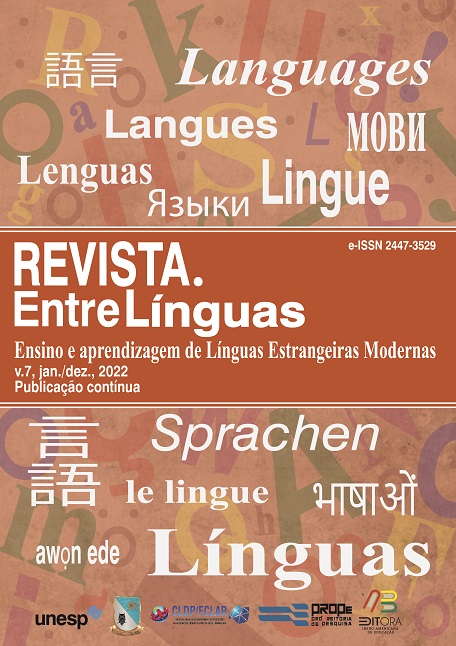How was the common communication language dropped in the turkish world?
DOI:
https://doi.org/10.29051/el.v8i00.17679Keywords:
Tsarist Russia, Turkic republics, Cyrillic alphabetAbstract
Turkish communities living in various geographies of the world have played an important role in every period of history. By the middle of the 10th century, the establishment of the Karakhanid state and its Islamic period started a new era for the Turks. Influenced by this civilization, they used the Arabic alphabet until the first quarter of the 19th century. 20th century Russian Turks had bad results. According to the "Policy of Nationalities", the Soviets divided the geography in the USSR. Stalin implemented the policy of Tsarist Russia to dissolve Turkish communities more quickly and abolished the Arabic alphabet used by Turks with the decisions taken at the 1926 Baku Turkic Congress. After that in 1928, Turkey changed the alphabet and got the same alphabet. The cultural unity among the Turks would be revived but Moscow was hesitating. Without wasting time, USSR brought the Cyrillic alphabet and ultimately, the new generation has cut off contact with each other.
Downloads
References
AGHAMALIOGHLU, S. Written Language and Culture of the East. Baku: VSK. NTA New Turkish Alphabet Soviet Central Committee, 1928. v. 1.
BABAYEV, A. The Open and Hidden Sides of the First Turkology Congress. Azerbaijan: University of Languages Publications, 2016.
BAKU TURKOLOGY CONGRESS. Ankara: Turkish Language Association Publications, 2008.
BAYRAMOVA, A. The New Beginning of the Science of Turkology in the XX Century: I. Baku Turkology Congress, Azerbaijan Journal of History and Methodology, v. 3, p. 12-15, 2016.
BURAN, A. Soviet Turkology and First Turkology Congress, Turkish Studies International Periodical for the Languages, Literature and History of Turkish or Turkic, v. 4/3, p. 23, 2009.
BURAN, A. Bulleted Turkology. Ankara: Akçağ Publications, 2010.
CHAQUERI, C. First Congress of Eastern Peoples. England: Cambridge University Press International Journal of Middle East Studies, v. 26, n. 4, p. 711, Nov. 1994.
DEMIREL, O. F. I. In: TURKOLOGY CONGRESS, Ankara, 1992. Proceedings […]. Ankara: Turkish Historical Society Publications, 1999.
DEVLET, N. Opening Speech of the International Symposium on Contemporary Turkish Alphabets. Istanbul: Marmara University Publications, n. 509, 1992.
FIRST TURCOLOGY CONGRESS. Report 26 February-5 March 1926,1. bs. Azerbaijan: Ministry of Culture and Tourism Publications, 1926
FIRST TURKOLOGY CONGRESS REPORT MINUTES. 26 February-5 March 1926. 1. ed. Azerbaijan: Ministry of Culture and Tourism Publications, 2011.
GALANTI, A. Arabic Letters Do Not Prevent Our Progress. Istanbul: Bedir Publishing House, 1996.
GASOMOVA, B. “Historical Development Process of the Azerbaijani Alphabet Azerbaijan Press in the Transition Process from the Arabic Alphabet to the Latin Alphabet (New Way, New Idea, Işık Yol)”. Turkish World Journal of Language and Literature, v. 51, p. 39-40, Spring, 2021.
HÜRREMKIZI, A. The Participation of Turkic Peoples and the Issue of Elifba in the Turkology Congress. Azerbaijan: National Academy of Sciences, 2016.
KAZIMOGHLU, M. The Invisible Side of the First Turkology Congress. Azerbaijan: National Academy of Sciences, 2016.
KHOJAYEV, K. S. My Old Memories and Emotions on New Elifba Ways. Baku: Manuscripts Department No: 496-362-81, 1929.
KILICH, R. Educational Issues in Turkey and Turkish Republics. Available: http://host.nigde.edu.tr/remzikilic/makale/index.php?entry=entry091114-201135. Access: 02 June 2020.
KOLTUK, N. Azerbaijan in Ottoman Documents. Istanbul: TDBB Publications, 2015.
NERIMANOGHLU, K. V. 1926 Baku Turkology Congress. Baku: Chinar, 2006.
NESIROVA, A. Latin Alphabet Stages in Azerbaijan. Azerbaijan: Ministry of Education Publications, 2019.
ORDBADY, M. S. Yeni Yol Newspaper, 07.12.1927. Azerbaijan Archive. Place No: 26452. p. 34. 1927.
OTTOMAN STATE ARCHIVE. Archive 30-18-1-1 / Department of Decisions (1920-1928) Location: 17-91-9.
POLIVANOV, E. D. “One of the Theorists of Soviet Language Policy A. Sh.Bikkulova”, Journal of Young Science, v.12, p. 219, 2011.
SARAY, M. Language and Culture Union in the Turkish World. Ankara: Turkish Language Association Publications. 2008.
SHERIFOGHLU, O. Defense of Islamic Letters. Istanbul: Sebil Publishing. 1997.
SHIMSHIR, B. N. History of Turkish Alphabet in Azerbaijan. Ankara: Turkish Historical Society Publications. 1991.
TACEMEN, A. Changing the Alphabets of the Turks under Russian Rule, (1769-1940). Kayseri: Erciyes University Publications, n. 68, 1994.
TOKER, M. Khalid Who Played a Major Role in Turkistan's Transition to the Latin Alphabet Seid Hodjayev and New Elifba Roads Old Memories and My Feelings. In: TURKOLOGY CONGRESS, Ankara, 1996. Proceedings […]. Ankara: Turkish Historical Society Publications, 1999.
TOYNBEE, A. J. The adoption of the Latin in place of the Arabic alphabet in Turkey and in the Turkish States Members. London: Oxford University Amen House, 1929.
TURKMEN, F. Common Alphabet Language Transition to Latin alphabet in Kazakhstan, Uzbekistan, Azerbaijan. New Turkey, v. 101, p. 318-319, May/June, 2018.
WHITE, S. Communism and the East: The Baku Congress, 1920. England: Cambridge University, 1974.
YENI YOL NEWSPAPER. Azerbaijan Manuscripts Department. Place No: 07 (49-924) J-56,1927.
YESILYURT, Z. Russification Policy in the Soviets and Murdered Intellectuals. Turkish Culture, v. 165, p. 562, 1976.
Published
How to Cite
Issue
Section
License

This work is licensed under a Creative Commons Attribution-NonCommercial-ShareAlike 4.0 International License.
Os manuscritos aceitos e publicados são de propriedade da Revista EntreLínguas. Os artigos publicados e as referências citadas na Revista EntreLínguas são de inteira responsabilidade de seus autores.
Transferência de direitos autorais – autorização para publicação
Caso o artigo submetido seja aprovado para publicação, já fica acordado que o(s) autor(es) autoriza(m) a UNESP a reproduzi-lo e publicá-lo na EntreLínguas, entendendo-se os termos “reprodução” e “publicação” conforme definição respectivamente dos incisos VI e I do artigo 5° da Lei 9610/98. O artigo poderá ser acessado pela rede mundial de computadores (Internet), sendo permitidas, a título gratuito, a consulta e a reprodução de exemplar do artigo para uso próprio de quem a consulta, desde que haja a citação ao texto consultado. Essa autorização de publicação 328 EntreLínguas, Araraquara, v. 1, n .2, p. 323-328, jul./dez. 2015 não tem limitação de tempo, ficando a UNESP responsável pela manutenção da identificação do(s) autor(es) do artigo. Os artigos publicados e as referências citadas na Revista EntreLínguas são de inteira responsabilidade de seus autores.











